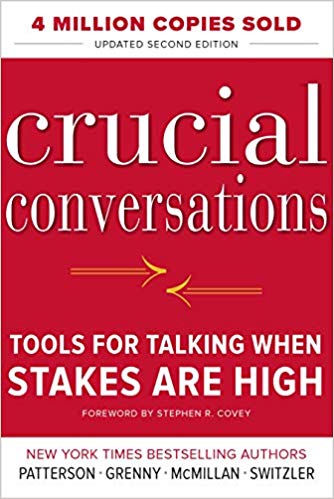

This article is an excerpt from the Shortform summary of "Crucial Conversations" by Kerry Patterson. Shortform has the world's best summaries of books you should be reading.
Like this article? Sign up for a free trial here .
What is body language? What can Crucial Conversations tell us about body language, and how it affects our conversations?
Body language is just as important as verbal communication. Your body language and that of the person you’re talking to can change the conversation—keep reading to find out how to control your body language and listen to other peoples’ body language in Crucial Conversations.
Control Your Emotions and Your Body Language
By learning to control your emotions, you’ll be in a better position to use the tools discussed so far (dual processing, contrasting, creating mutual purpose, etc.) to have successful crucial conversations.
Getting a better understanding of how emotions work is the first step. When we lose our cool we tend to blame others for pushing our buttons or making us mad. But we’re the drivers of our emotions, which in turn drive our actions.
Emotions don’t just happen. Here are two truths about them:
- Emotions aren’t forced upon you by others. Others don’t make you mad; you make yourself mad. You create your own emotions — you make yourself angry, insulted, or frustrated.
- Once you’ve created your emotions, you can do one of two things: Rethink them or be driven by them to act in unproductive ways. To put it another way, you either control your emotions, or you’ll be controlled by them.
Here’s an example of how emotions can lead to unproductive behavior. Maria is a copywriter who worked with her boss, Louis, on a project, which they were supposed to present jointly. But Louis presented the entire project himself without giving Maria a chance to speak. She’s angry and resentful, and she feels betrayed. Nonetheless, she doesn’t want to come across as oversensitive, so she doesn’t tell Louis she’s upset. Instead, she erupts occasionally with sarcasm (masking) and cheap shots (avoiding), which is jeopardizing their working relationship.
Maria’s story illustrates some of the pitfalls of not controlling your emotions. If you don’t control your emotions, matters will get worse. On the other hand, if you suppress them, they’ll still surface, for instance through sarcasm or body language. Either way, you’re being held hostage or driven by your emotions, which makes conversation impossible.
How to Listen to Other People
To encourage others to share, use four listening tools: Ask, mirror, paraphrase, prime (AMPP).
A: Ask
Ask to get things going: Often all it takes to break an impasse is to seek to understand others’ views. When you show genuine interest, people feel less compelled to use silence/violence. For example, use phrases like, “What do you mean? I’d like to hear your concerns.” Other invitations include: “What’s going on?” “Please let me know if you see it differently.” “Don’t worry about hurting my feelings; I really want to hear your thoughts.”
M: Mirror
Mirror to confirm feelings: Mirroring can help build more safety. It consists of playing the role of mirror by describing to the person how they look or act. We see their actions and reflect them back.
Mirroring is most useful when the other person’s tone/gestures are inconsistent with their words.
For example, they may say, “Don’t worry, I’m fine,” when clearly they’re not fine. A mirroring response would be, “Really? It doesn’t sound like you are.” Explain that while the person may be saying one thing, his body language or tone belies it. For instance, “You look nervous about signing the contract. Are you sure you’re OK with buying this car?”
With your tone, convey that you’re OK with them feeling the way they’re feeling; respond calmly rather than being upset.
P: Paraphrase
Paraphrase to acknowledge the story: When you get a clue for why the person is feeling the way they do, you can build additional safety by paraphrasing what you heard. Don’t just parrot back what they say, but put the message in your own words in abbreviated form. For instance, “Let’s see if I’ve got this right. You’re upset because…”
Don’t react negatively. Stay focused on figuring out how a reasonable person could have concluded this. Rephrase in a way that suggests it’s OK to speak, that you’re trying to understand. You can use this time to reframe your body language in crucial conversations.
P: Prime
Prime when you’re still stalled: When you believe another person still has something to share and might do so with further encouragement, you can try priming the conversation. Offer a guess at what the other person is thinking or feeling, and she may respond. For example, “Are you thinking that the only reason we’re doing this is to make money?”
Don’t Push Too Hard
When you can tell the other person has more to share, but isn’t sharing it, you may want to back off. Repeated attempts to encourage sharing can feel like pushing. So end the conversation tactfully, or ask what they want to see happen. This question helps them move toward problem solving (away from silence/violence).
Body language in crucial conversations can be difficult to understand, and it can also be hard to control your own body language. Being aware of what you’re saying and how you’re coming across can help you have a much more productive conversation.

———End of Preview———
Like what you just read? Read the rest of the world's best summary of Kerry Patterson's "Crucial Conversations" at Shortform .
Here's what you'll find in our full Crucial Conversations summary :
- How to approach an argument without getting mad
- The mistakes most people make when trying to listen to someone else
- How to come up with win-win solutions that make everyone happy






